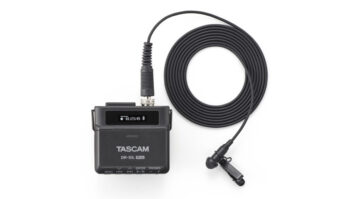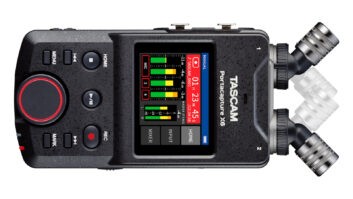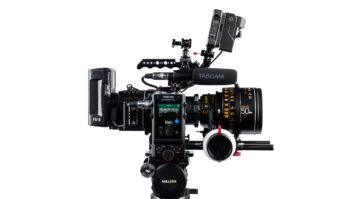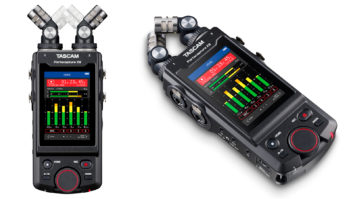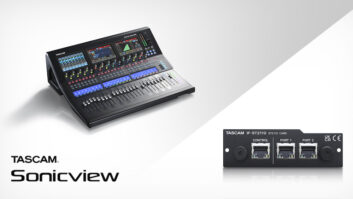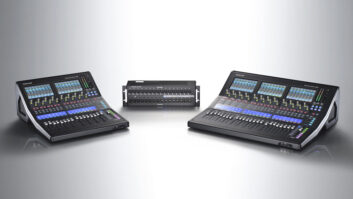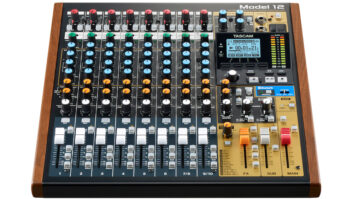If Les Paul is considered the father of multitrack recording, then Tascam should be considered the pioneer of home studio recording. The company started the trend in home recording in the early ’70s with models such as the 3340 ¼-inch 4-track tape recorder and the cassette-based Portastudio. Its newest 2-track recorder, the DV-RA1000, is definitely a pro unit, but its price makes it suitable for home studios. It is the first affordable stand-alone 2-track recorder capable of recording high-resolution PCM digital audio (up to 192 kHz) and DSD audio, the basis of the Super Audio CD; other systems capable of recording DSD format cost five to 10 times as much.
MEDIA AND MODES
The DV-RA1000 writes directly to DVD+RW and CD-R/RW media. When a CD-R or CD-RW is inserted into the drive, the DV-RA1000 switches to CD mode and only allows recording at 44.1 kHz/16-bit — the Redbook standard for audio CDs. When a DVD+RW is inserted, the deck switches to DVD mode and all of the PCM sampling frequencies are available, from 44.1 kHz to 192 kHz, but only at 24-bit. DSD recording, which operates at 2.8 MHz/1-bit, is also available in DVD mode.
DVD media is formatted in UDF 1.5 format and can be read by personal computers with DVD drives. A USB mode makes the DV-RA1000 appear on a PC (Windows or Mac OS) as a removable USB mass storage device. I plugged my Mac laptop into the DV-RA1000’s USB port and burned a DVD+RW disc using Toast.
FEATURE BONANZA
Tascam has packed lots of features into the DV-RA1000. The front panel is intelligently laid out with a jog wheel, transport controls and dedicated buttons for setting markers, display options, input level and menu access. There are four buttons for effects (digital EQ and dynamics), I/O monitoring, fade (in or out) and a Sync Record button. Sync Record allows the unit to record only when it detects audio above a preset threshold or if the co-ax input is selected when it detects a track ID. The unit does not have timecode provisions, but it will accept word clock sync.
Five user-programmable buttons are set by default to input select, reference clock, calibrate, preferences and UDFMI-save. The remainder of the DV-RA1000’s parameters are set using the Virtual Front Panel (VFP) or by navigating the menu pages. The VFP is shown on the LCD when the Enter button is pushed and provides access to 15 functions, including pitch, dither, oscillator and finalize. A wired remote-control unit duplicates or complements the keys on the main unit, and a front panel PS/2 QWERTY keyboard is useful when naming projects, markers and audio files or when entering up to 1,000 characters of text, which is saved with each project.
The back of the DV-RA1000 offers balanced +4dBu XLR and unbalanced -10dBV RCA analog inputs and outputs. All digital formats are supported with S/PDIF (up to 96 kHz), AES (single and dual wire, up to 192 kHz) and BNC connectors for SDIF-3 and DSD-raw. Word sync In, Out and Thru, RS-232C serial control and the USB 2 connector are also on the back.
A MASTERLINK KILLER?
Ever since the Alesis Masterlink came out, it has been my choice for high-resolution digital mixdown. Everyone I know who owns or uses the Masterlink has asked me the following question: Is the DV-RA1000 a Masterlink killer?
The answer is yes — and no. No, because they are different machines that perform similar functions. The Masterlink is a two-drive machine, which gives it certain advantages over the DV-RA1000, such as the ability to print high-resolution mixes, reorder them, add processing and sample rate — convert them internally to make a CD that will play in any CD player. The DV-RA1000 beats the Masterlink when it comes to supported formats and features, but it is a single-drive unit that should be thought of as a data recorder (like a tape machine). If the DV-RA1000 is your master mixdown machine and you want to listen to your mix on another system, you will have to make copies to a second machine or print the mix twice: once to DVD and once to CD-R.
In my opinion, the DV-RA1000’s biggest advantage is that it will record DSD audio. Many engineers, producers and artists who have compared DSD to PCM have preferred the DSD audio. So the answer to the Masterlink killer question, in regard to sonics, in my opinion is yes.
For listening tests, I set the Masterlink at 96/24 and printed the same mix on the DV-RA1000 at 96 kHz/24-bit, 192 kHz/24-bit and at the DSD setting. I was not surprised when I found that I preferred the sound of the DV-RA1000 at the higher sampling formats, especially when recording DSD-formatted audio. It sounded more open and natural than the Masterlink, as well as sounding closer to the source. I did the same test with both machines set to 44.1/16-bit and I still preferred the DV-RA1000.
I also connected each machine to an Apogee Big Ben master clock. The Masterlink sounded better when externally clocked, while the DV-RA1000 sounded better when set to its internal clock.
WISH LIST ASIDE, LOVE THE SOUND
There are some things I wish this machine would do, such as allowing me to print to an external hard drive or the ability to digitally down-convert to an external CD-R burner. I would also be nice if it played back commercial SACD discs (at least the stereo tracks). The transport buttons are also a bit flimsy. But these are minor issues. The DV-RA1000 is a great-sounding machine with tons of features at an amazing price of $1,499.
Tascam, 323/726-0303, www.tascam.com.
Erik Zobler is an L.A.-based mixer.
